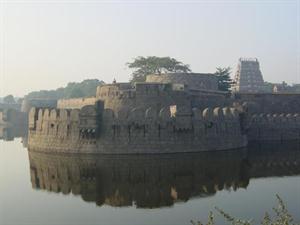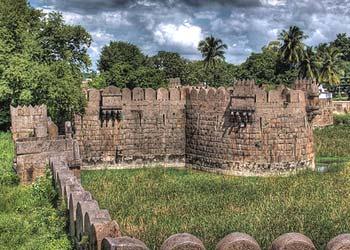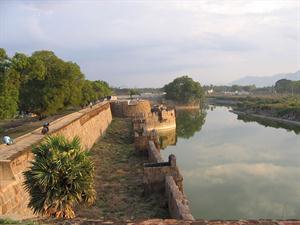Vellore Fort Near Chennai
Vellore is called as a Fort City, fortress within itself has a temple called Jalagandeeswara temple constructed under the rule of Vijayanagara empire which is situated approximately 145kms from metropolitan city Chennai. Vellore fort is built during the perios of 16th century. This article provides the details about Vellore fort.
Vellore – The Fort City
Vellore is also called as Fort city which is one of the shrines in Vellore. This is the greatest 16th century fort situated at Vellore city which is 145kms (approx.) from grand Chennai in the state of Tamil Nadu, India. Once upon a time this fort was the headquarters of Vijayanagara Empire. The Vijayanagara kings called this as "Raya Vellore" to make different from "Uppu Vellore" which is situated in Godavari region. The name Vellore also spelt as Belur.  This fort is recognized for its impressive walls, wide trench surrounds the fort in all sides and strong free masonry. Initially, the fort was ruled by Vijayanagara empires, then it was passed to Bijapur sultans after that to Marathas then to Mughals followed by Carnatic Nawabs and finally to Britishers. The Britishers apprehended the fort until India gets Independence. During the period of British, the last king of Ceylon (nowadays called as Sri Lanka) called as Vikrama Rajasinha and Tippu sultan's Son and Daughter were imprisoned in this great fort.
This fort is recognized for its impressive walls, wide trench surrounds the fort in all sides and strong free masonry. Initially, the fort was ruled by Vijayanagara empires, then it was passed to Bijapur sultans after that to Marathas then to Mughals followed by Carnatic Nawabs and finally to Britishers. The Britishers apprehended the fort until India gets Independence. During the period of British, the last king of Ceylon (nowadays called as Sri Lanka) called as Vikrama Rajasinha and Tippu sultan's Son and Daughter were imprisoned in this great fort.
The Fort within this consists of a Hindu temple, Muslim Mosque and a Christian Church. The Hindu temple is famous for its wonderful sculptures. The first revolution in opposition to British rule explodes at this fort in 1806. This is one of the eye witness awful mass murder of the Vijayanagara empire family of Emperor Srirangaraya. We can call this Fort as a place of pilgrimage, a holy place, a place of workship, Vijayanagara fort, etc. Presently Andhra Pradesh and Karnataka are under the sphere of influence of this Fort. Rule of Vijayanagara Kings
Vellore Fort was ruled by Vijayanagara Empire during the period from 1566 to 1656. This fort achieves premeditated celebrity after the reinstatement of Vijayanagara empires with Chandragiri which is their of 4th capital subsequent to Talikota war. During 17th century the Aravidu Dynasty kept Rayas in their custody in the  Fort and which is the pedestal for the Toppur battle in 1620. This terrible battle takes place because of declaration of Raya name between two splinter groups of Raya Families. Each groups have their own subordinates and they are the Nayaks of Tanjore, Nayaks of Gingee and the Nayaks of Madurai. The Rayas had long-running battles with their opponents. During the period of Srirangaraya III, the fort was captured by Bijapur Sultans in 1640. This was again re-captured by Srirangaraya III with the help of Nayaks of Tanjore.
Fort and which is the pedestal for the Toppur battle in 1620. This terrible battle takes place because of declaration of Raya name between two splinter groups of Raya Families. Each groups have their own subordinates and they are the Nayaks of Tanjore, Nayaks of Gingee and the Nayaks of Madurai. The Rayas had long-running battles with their opponents. During the period of Srirangaraya III, the fort was captured by Bijapur Sultans in 1640. This was again re-captured by Srirangaraya III with the help of Nayaks of Tanjore.
In the year 1614, during the period of Srirangaraya, a revolution takes place within the Raya family and the reigning king Srirangaraya and his total family were killed except emperor's younger son Ramadevaraya pulled out from the fort by several supporters in the fort. Due to this incident, battle of Toppur takes place in 1616 which is one of the major south Indian battles with all Nayak leaders taking part. At last this war was won by minor Ramadevaraya putting of the finishing touch and so called as Aravidu Vijayanagara Empire in the year 1617.Rule of Bijapur Sultans
After the capture of Vellore fort from Vijayanagara empires, the fort was ruled by Bijapur Sultans during the period from 1656 to 1678. In the year 1650, Srirangaraya in association with Nayaks of Mysore and Nayaks of Tanjore protest rally south to attack Gingee and Madurai. At first Srirangaraya captured Gingee fort and soon after Thirumalai Nayak from Madurai requested Bijapur Sultans to harass Vellore fort in order to divert Srirangaraya's attention. The Sultan of Bijapur quickly sends off a huge army forces and captured Vellore fort. Consequently, Nayaks of Madurai and Sultans of Bijapur merged together on Gingee by defeating the Vellore-Tanjore armed forces. After a confrontation Gingee fort and Vellore fort are ruined up in the hands of Bijapur Sultans. This defeat shows the end of last direct line of Vijayanagara empires. Within a very short period, these forts were held by Marathas from Sultans of Bijapur.Rule of Marathas
The Marathas captured Vellore Fort after 20 years reign of Bijapur Sultans under Shivaji. They held the Vellore Fort under their control from 1678 to 1707. Architecture of Vellore Fort
This fort was built by Chinna Bommi Nayak and Thimma Reddy Nayak during the period from 1526 to 1595 AD. This is one of the finest wonderful specimen of military structural design.  The enrichment of the fort consists of core bulwark wrecked at asymmetrical distance by circular tower and rectangular protrusion. The walls are built with kangaroo stones of rectangular silhouette. The ramparts of the fortifications are joined together so that the outer wall becomes lower than the other which is extended towards the inner wall with a shutter of gigantic thickness. The upper walls are wrinkled with brick works. This is the evident work of the European engineers during the later period of fort's history.
The enrichment of the fort consists of core bulwark wrecked at asymmetrical distance by circular tower and rectangular protrusion. The walls are built with kangaroo stones of rectangular silhouette. The ramparts of the fortifications are joined together so that the outer wall becomes lower than the other which is extended towards the inner wall with a shutter of gigantic thickness. The upper walls are wrinkled with brick works. This is the evident work of the European engineers during the later period of fort's history.
The tapered wall running around the fort can be reached by a voyage of steps at the entrance of the fort. The central walls are constructed strongly with stone cuts and filled together without field gun. On the southern area there is a raised fortress on which the staff who hoists the flag stands. There are two tiny towers raised in the main works at the south-east and north-east angles. The old entrance was by means of a wading through fare with immense gates which is protected by drawbridge. This way was altered during 18th century and adopted for defence by missiles. So we can call Vellore Fort as a good specimen of military architecture in south India which is still in good protection. The outer length of the fort is around 2500 feet and 1500 feet in breadth. The outer wall is about 30 feet in length and 25 feet in breadth. The circumference of the fort is around 2500 meters approximately. This fort was constructed mostly for defensive purposes and this was made comparatively broad and deep. The fort and the temple inside the fort were under the preservation by state government of India in the year 1921.Drawbridge in Vellore Fort
The wide ranging defensive trench round the castle usually filled with water which ambiance the fort, receives water from Suryagunta tank which is a huge reservoir situated near the railway station. Long time ago, this moat consists of ten thousands of crocodiles. This moat is dry today in southern region also some parts from eastern and western sides also countenance the same. The moat serve up the inner boundary, the river palar serve up the northern boundary and on the eastern side had a long trench especially in a fortification in Madras-Bangalore highway along with the adjoining hills and finally some leftovers are found on the road side. The circumference of the drawbridge (moat) is about 8000 feet at a length and depth of 190 feet.
The fort and the temple are under conservation of State Government of Tamil Nadu. Conceivably the moat environs the inner boundary of the fort, presence of river palar in the northern boundary and in the eastern side it covers the Chennai-Bangalore highway at Sathuvachari along with bordering hills which all together surrounds the fort and Jalagandeeshawara temple. Hotels in Vellore
Most of the Hotels in Vellore are 7*24hrs depart. Some of the famous hotels in Vellore are Srinivasa Lodge, Naga International Lodge, Hotel Park, Hotel River View, Hotel Mount Paradise, Darling Residency, Hotel Ganga, and Prince Manor. Travelling in Vellore
Important mode of transportation in Vellore is mostly autos and buses. The main railway station is at Katpadi which is 4kms from Vellore. One can reach Vellore in 3 hrs from Chennai and Bangalore approximately.





